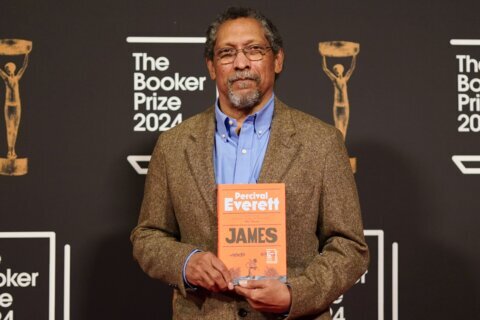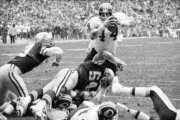WASHINGTON – He brought us one of the most famous deaths in movie history.
Now, actor Alex Rocco has died at the age of 79.
Fans of Francis Ford Coppola’s “The Godfather” (1972) remember Rocco for his iconic role as Las Vegas casino boss Moe Greene, who befriended Fredo Corleone (John Cazale) before taking a bullet through the eye courtesy of Michael Corleone (Al Pacino) during a climatic baptism murder montage.
While Rocco had very little screentime, his impact on the “Godfather” legacy is immeasurable.
Scene #1: The Threat
In the final third of “The Godfather,” Vito Corleone (Marlon Brando) has handed the reins of his crime family over to his favorite son, Michael (Pacino), who was never meant to get mixed up in the family business. Michael’s first move is to expand the Corleone Family to Las Vegas, putting him on a collision course with the man who built much of Vegas, casino magnate Moe Greene.
Michael arrives to find Greene mistreating brother Fredo — sparking an argument that causes Greene to storm out with the famous line: “Do you know who I am? I’m Moe Greene! I made my bones when you were going out with cheerleaders!” Michael turns to his brother Fredo, warning, “Fredo, you’re my older brother and I love you. But don’t ever take sides with anyone against the family again. Ever.” It’s brilliant foreshadowing of the events in “The Godfather Part II” (1974).
Scene #2: The Murder
During the first film’s climax, Michael wipes out all of his enemies in Coppola’s legendary Baptism Murder Montage. As Michael becomes a “godfather” in more than one sense of the word, Coppola intercuts the horrific acts of violence with Michael’s disingenuous vows in the Catholic Church: “Do you renounce Satan?” “I do renounce him.” It’s here that Moe Greene meets his fate on a massage table, as a bullet enters his eye through his glasses, sending a stream of blood down his face.
Special effects supervisor A.D. Flowers explained the stunt: “For the first time in my life, a director comes up to me [and says], ‘You’ve got nearly all the time you want, you will have all the money you want to spend, let’s kill somebody in a manner that’s never been [done] before.’ … Well, that’s where we came up with the idea of shooting Moe Greene in the eye through his glasses.”
Makeup artist Dick Smith added: “The glasses you remember were fairly thick, tortoise shell kind of thing, so they had two small tubes running along from behind the head along the stem towards the glass, and with air pressure they would first blow a tiny BB at high pressure through breakaway glass so that the force of the BB hitting it would be sure to explode outward and away. And the other tube contained blood and probably almost simultaneously one! two! the blood was squirted and it hit the broken glass. A.D. created all that. So you had that incredible effect where it looked like it was going out but it was really going in.”
Flowers continued: “At the same time we blew air so that no particles of the breakaway glass would go into the man’s eye. And with me and with I would say 99% of all the effects men our main concern is safety. You want to get a good shot, but you also don’t want to hurt anybody. It was a safety precaution to add the air; the breakaway glass is actually plastic, but it does have chips in it. And this I had tried before but due to the time element of shooting — it was for TV — we never did get it properly. It’s a tricky shot, and with a feature you have more time than you do with a [TV] movie.”
Scene #3: The Aftermath
After “The Godfather” (1972) won the Oscar for Best Picture, the sequel, “The Godfather Part II” (1974), also won Best Picture — becoming the only original and sequel to both with the top prize.
Moe Greene’s character was obviously deceased by the time of Part II, but his legacy lived on through new villain Hyman Roth (Lee Strasberg), who recounted Greene’s backstory while dealing with Michael during their expanses into Havana, Cuba:
“There was this kid I grew up with, who was younger than me, so he looked up to me. We did our first work together, worked our way out of the street. Things were good. We made the most of it. During Prohibition, we ran molasses into Canada, made a fortune, your father, too. As much as anyone, I loved him and trusted him. Later on, we had an idea to build a city out of a desert stopover for G.I.’s on the way to the West Coast.”
“That kid’s name was Moe Greene, and the city he invented was Las Vegas. This was a great man, a man of vision and guts, and there isn’t even a plaque or a signpost or a statue of him in that town. Someone put a bullet through his eye. No one knows who gave the order. When I heard it, I wasn’t angry. I knew Moe, I knew he was headstrong, talking loud, saying stupid things, so when he turned up dead, I let it go. And I said to myself, ‘This is the business we’ve chosen! I didn’t ask who gave the order! Because it had nothing to do with business.”
https://www.youtube.com/watch?v=9zfGdG79taE
As Roth exits the room, Michael’s black-clad hitman waits dangerously in the background.
In the “Godfather” saga, everything is cyclical, outcomes are fatalistic, and karma is hell.
Rest in peace, Alex Rocco — and thanks for giving us a movie legend in Moe Greene.
“Do you know who I am?” Yes, we most certainly do.













